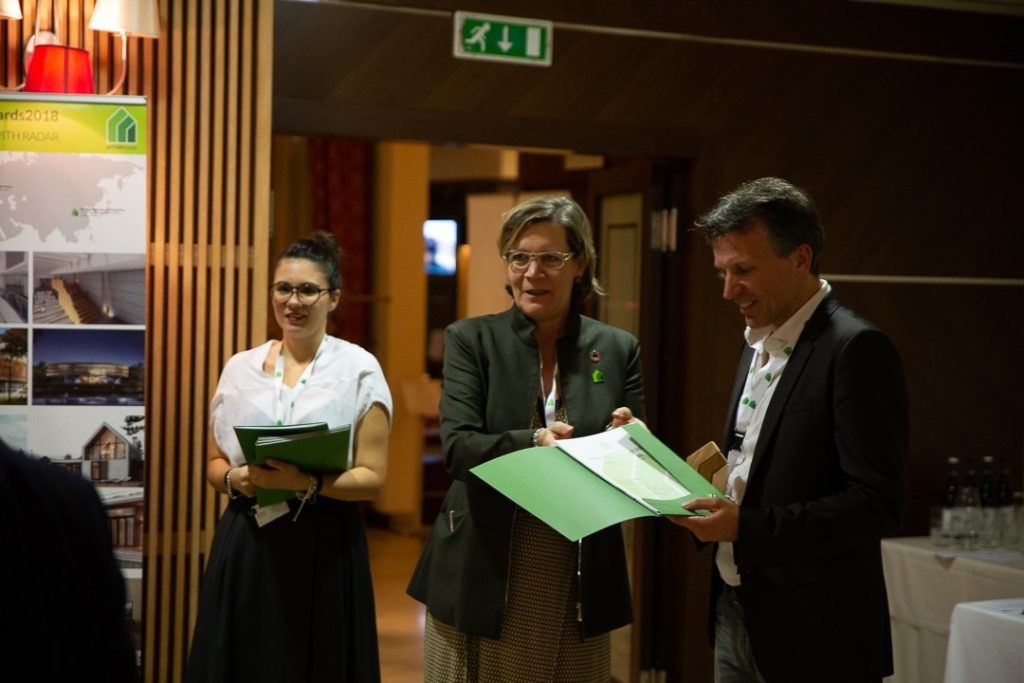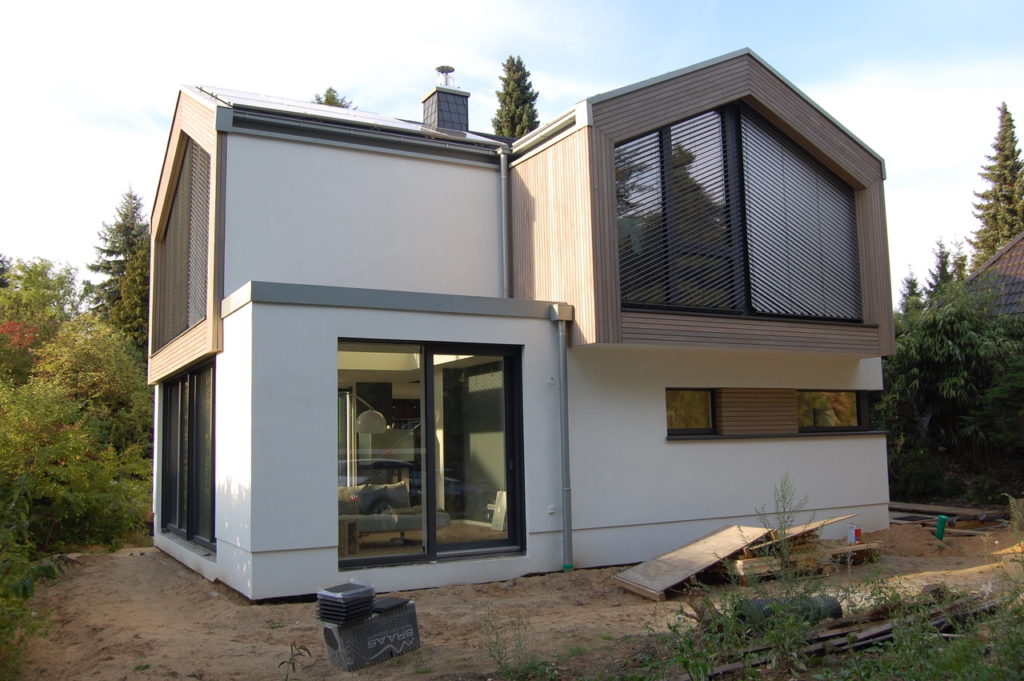Putting Active House to the test: S8

The S8 is a one family house in Hamburg, Germany designed by Wolfram Trinius and Kai Steppan for Wolfram Trinius. The project won an Active House Award at the 2018 Active House Symposium. Below Wolfram Trinius answers a few questions on behalf of the S8 project.
Your project won an award at the Active House Awards this year, congratulations. Why did you submit your project for the Active House Awards?
A couple of years ago, I was involved in the evaluation of the VELUX model home 2020 in Hamburg. Following that, I participated in a couple of workshops developing the Active House approach. Together with my involvement in the technical committee of the German Sustainable Building Council (DGNB), this work experience defined my framework of reference when deciding to design and build my own building. To me personally, the project is a reality check: am I am ready to act privately as I consult and teach in my professional projects?
In that context, it is important to not only claim your success but to have somebody else judge your project. Submitting to the Active House award sounded like the perfect idea, as the jury is international and entirely committed to highly energy efficient sustainable homes. As I regard the Active House concept to be a highly significant point of reference for construction that is suitable for the future, receiving the award in the context of other really remarkable and outstanding projects just simply feels incredibly rewarding.
What does winning the Active House Award mean for your project/organisation? What would you say are some of the key features that make Active Houses better buildings?
First, it was an enormous surprise. I knew we had done many things right, but receiving the award also means that we found a convincing balance in the overall project. We started with the construction concept of a local small-house builder. And successively improved and adapted it, focussing on the ability of the builders and craftsmen to deliver without forcing them onto unknown terrain. Facing quality risks or NASA price tags was no option. Being an energy and sustainability consultant to the builder, while also being their client was a very fascinating position. As a result, the project shows that it is possible to turn a “standard performer” into a surplus energy building – without compromising on design, indoor qualities, comfort and so on. If we can transform one, it can be repeated. The replicability is where I see a key for future business development of my professional practice as well.
Now, what makes active houses better buildings? It is not only energy. Nor is it only eco. Active Houses show that there is no conflict between Energy, Environment and Comfort. You can bring these aspects together without compromising other elements of concern. That is what makes them truly sustainable. Thinking about our countries not fulfilling global nor national climate and energy policy goals, seeing the nearly zero energy building requirement being soft-toned into a level that does not require significant changes, active houses demonstrate that each decision taker, each building can make that change anyway. You can build zero or surplus energy. Without compromising comfort or health, rather exactly the opposite! And it is worth it. For the user, for the planet, for the future. Not 2030, but now.

At this year’s symposium there was a lot of talk about digitalisation and technology changing our buildings. How does your project use these?
I do have split opinions about many “smart technologies”, especially when it means that information is gathered and fed into systems where I as a person am out of control. I am also not convinced that it is smart to build technologies with a 5-year redundancy cycle into a building that is supposed to be functional for the next 50 years. When there are open standards with many product suppliers in the market (like KNX), I assume these can be updated and you will also find new elements when you need to expand or replace parts of your systems. I find open standards much more appealing than proprietary standards with single or a few parties supplying functions or services. Long-term reliability and really the question of the added value for the user should stay in focus.
How do you think we can convince more people of the importance of healthy buildings? How does your project address this important aspect?
I do believe that the general awareness for healthy buildings and healthy building materials is in place. But it also appears that the builders are more on the “business as usual” part of the game, while future building users do not have the detailed knowledge about materials, construction options, technical solution and how they in combination have an influence on their health while using the building.
There are many scattered pieces of information on healthy buildings, or on healthy living in buildings. Possibly Active House could use its platform to involve physicians, material scientists, construction technology experts etc to gather knowledge, collect facts and spread the word.
Active House is all about comfort, energy and environment. How does your project incorporate these aspects?
We redesigned the building envelope, focussing windows, insulation and thermal bridges to outperform German regulation by 2/3. The ground conditions in Hamburg are rather perfectly suited for geothermal heat pumps. As a result, the energy demand reduces to slightly above 3kWh/m2a for heating, 2.5 for pumping energies, 5.3 for hot water and 1.55 for ventilation. Coming that low, it was obvious to cover that electricity demand by installing PV on the roof and to install a power storage to bridge the time difference between demand and supply at least on a daily scale. The PV system is designed to provide nearly three times the amount needed by the building – offering enough for user appliances and still making surplus energy worth 20.000km available to e-mobility. The building is truly surplus energy and will compensate the embodied CO2 after roughly 8 years.
Access to daylight was a key requirement for us. Preventing from overheating sounds like a joke in northern Germany but it is a necessity. For longer periods of hot conditions, the geothermal heat pump has a natural cooling function, the building can be cooled, and the energy is fed back into the boreholes. In summer 2018, at more than 40 degrees outside, inside temperatures peaked at 24 degrees.
Regarding environmental aspects, materials were selected carefully, referring to the DGNB requirements. Rainwater is treated locally.
One of this year’s speakers at the symposium suggested that as prices go up, so do the expectations of homebuyers. Do you think the Active House label can help purchasers identify good projects?
It will be essential that buyers can identify and judge the qualities of a building. Otherwise, they will not be able to decide whether a building meets their requirements and whether it ultimately is worth the price. Rather than relying on brokers, users would need a point of reference. The Active House radar could play that role. Meanwhile, some of the Active House criteria require significant work to generate information. This might be an obstacle.
If you were to give one piece of advice to next year’s contestants, what would it be?
Follow your project from the outset of the ideas, reflect on your requirements and goals and demonstrate how you keep your project on track throughout the design, detailed planning, procurement and realisation. This will generate awareness about difficulties and your approach to overcome obstacles. Where did you need to compromise, where was it easy to convince other involved parties? These will be interesting learnings for others and could be the starting point for you to tell the story about what makes your project a success.
Read more about the S8 project here


